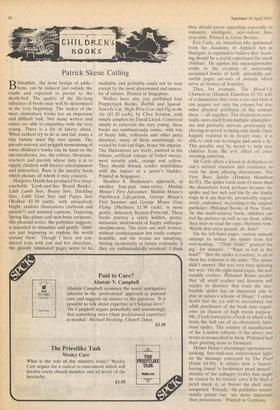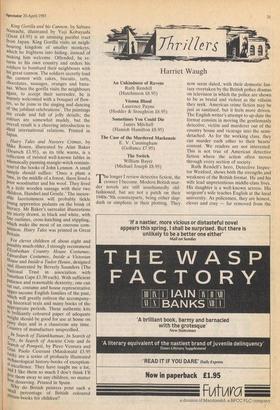Patrick Skene Catling
bliophi I y, the most benign of addic- tions, can be induced just outside the cradle and expected to persist to the death-bed. The quality of the life-long influence of books may well be determined at the very beginning. The maker of the most eleMentary books has an important and difficult task. Not many writers and artists are able to empathise with the very young. There is a lot of fakery about. When authors try to do so and fail, many a tiny tummy must flip into spasm. The pseudo-naivete and priggish sermonising of some children's books can be hard on the intermediaries, too, the editors, librarians, teachers and parents whose duty it is to supply children with literary entertainment and instruction. Rare is the nursery book which pleases all whom it may concern.
Hargrave Hands has produced five irrep- roachable 'Look-and-See Board Books', Little Lamb Sees, Bunny Sees, Duckling Sees, Little Goat Sees and Puppy Sees (Walker £1.50 each), with attractively bright, realistic illustrations (airbrush and pastels?) and minimal captions. Depicting Spring-like plants and new-horn creatures, this pleasant series, the publisher suggests, is intended to stimulate and gratify 'child- ren just beginning to explore the world around them'. Though I have not con- ducted tests with jam and hot chocolate, the glossily laminated pages seem to be washable and probably could not be torn except by the most determined and muscu- lar of infants. Printed in Singapore.
Walker have also just published four Flapperjack Books, Bubble and Squeak, Scaredy Cat, High-Wire Cow and Pig in the Air (£1.50 each), by Clive Scruton, with simple couplets by David Lloyd. Contrived simply to entertain the very young, these books are rumbustiously comic, with lots of funny falls, collisions and other petty disasters, many of them surprisingly re- vealed by fold-out flaps, hence the imprint. The illustrations arc lively, painted in the bilious, artificial colours of boiled sweets, most notably pink, orange and yellow. They should thwack tender sensibilities with the impact of a jester's bladder. Printed in Singapore.
Heather S. Buchanan's approach, in another four-part mini-series, Matilda Mouse's First Adventure, Matilda Mouse's Patchwork Life-jackets, George Mouse's First Summer and George Mouse Goes Flying (Methuen £1.99 each), is more gently, delicately Beatrix-Potterish. These books portray a safely hidden, pretty, miniature underworld of happy anthropo- morphisation. The texts are well written. without condescension but easily compre- hensible, and the stories are satisfying, hinting incidentally at future continuity if they are enthusiastically received. I think they should prove appealing especially to romantic, intelligent, non-violent five- year-olds. Printed in Great Britain.
Eric Carle, an American who graduated from the Academy of Applied Art in Stuttgart, is reported to believe that 'learn- ing should be a joyful experience for small children'. He applies this unexceptionable credo to the creation of universally acclaimed books of bold, splendidly col- ourful paper cut-outs of animals which serve as bearers of homilies.
,Thus, for example, The Mixed-Up Chameleon (Hamish Hamilton £5.95) tells of a chameleon that visits a zoo and finds it can acquire not only the colours but also other physical attributes of the animals there — all together. The chameleon even- tually saves itself from multiple schizophre- nia and probably nervous prostration by electing to revert to being only itself. Once happily restored to its proper state, it is able to stick out its tongue and catch a fly. This parable may be meant to help save children from the evil effect of over- weening ambition.
Mr Carle offers a lesson in dedication to one's natural vocation and resistance to even the most alluring distractions, The Very Busy Spider (Hamish Hamilton £6.95). The spider book costs more than the chameleon book perhaps because the spider and her web and the fly she finally traps in it are heavily, presumably expen- sively, embossed. According to the original publisher, Philomel Books of New York. 'In this multi-sensory book, children can feel the pictures as well as see them, while they hear or read the easy, rhythmic text.' Worth that extra pound, eh, kids?
On the left-hand pages, various animals attempt to seduce the spider from her web-making. "Oink! Oink!" grunted the pig', for instance. "Want to roll in the mud?" ' But the spider is resolute; to all of them her response is the same: 'The spider didn't answer. She was very busy spinning her web.' On the right-hand pages, the web steadily evolves. Philomel Books predict that 'all small readers and listeners will rejoice to discover that even the tiny, humble spider has an important role to play in nature's scheme of things'. I rather doubt that the joy will be unconfined, but adult purchasers of the hook may experi- ence an illusion of high moral purpose. Me, I look forward to a book in which a fly beats the hell out of an obsessively labo- rious spider. The country of manufacture of the London editions of the above two books is unspecified in them. Philomel had their printing done in Denmark.
Helme Heine's charmingly spontaneous- looking, free-and-easy watercolours light- en the message conveyed by The Pearl (Dent £4.95). It relates how a beaver. having found 'a freshwater pearl mussel', dreams of the unhappy rivalry that might he caused by his friends' envy if he finds a pearl inside it, so throws the shell away unopened. 'Friends,' the publisher senten- tiously points out, 'are more important than possessions.' Printed in Germany. King Gorilla and his Cannon, by Saburo Namachi, illustrated by Yuji Kobayashi (Dent £4.95) is an amusing pacifist tract from Japan. King Gorilla visits an neigh- bouring kingdom of smaller monkeys, which he frightens into hiding, instead of making him welcome. Offended, he re- turns to his own country and orders his soldiers to bombard their neighbours with his great cannon. The soldiers secretly load the cannon with cakes, biscuits, tarts, Chocolates, sausages, oranges and bana- nas. When the gorilla visits the neighbours again, to accept their surrender, he is warmly welcomed with a bouquet of flow- ers, so he joins in the singing and dancing of 'the jubilant celebrations'. The paintings are crude' and full of jolly details; the eolOurs are somewhat muddy, but the Overall result is a cheering introduction to ideal international relations. Printed in Japan.
Hairy Tales and Nursery Crimes, by Mike Rosen, illustrated by Alan Baker (Deutsch £3.95), as its title warns, is a Collection of twisted well-known fables in Whimsically punning mangle-witch reminis- eenrof the books of John Lennon. A small sample should suffice: 'Once a plum a time, in the middle of a forest, there lived a Poor woodnutter and his woof. They lived in a little wooden sausage with their two Children, Handsel and Gristle.' The inexor- able facetiousness will probably tickle Young apprentice pedants on the brink of literacy. Mr Baker's surrealist illustrations are nicely drawn, in black and white, with line outlines, cross-hatching and stippling, Which make the most of an onerous com- mission. Hairy Tales was printed in Great Britain.
For clever children of about eight and Possibly much older, I strongly recommend Elizabethan Country House Costumes, Edwardian Costumes, Inside a Victorian House and Inside a Tudor House, designed and illustrated by Beverly Saunders (The National Trust in association with Jonathan Cape £3.50 each). With sufficient Patience and reasonable dexterity, one can cut out, costume and house representative Upper-income English families of the past, Which will greatly enliven the accompany- ing historical texts and many books of the appropriate periods. These authentic kits In brilliantly coloured paper of adequate Weight should be good for use at home on r.,rainy days and in a classroom any time. `-ountry of manufacture unspecified.
In Search of Tutankhamun, In Search of Troy In Search of Ancient Crete and In Search of Pompeii, by Piero Ventura and 'Sian Paolo Ceserani (Macdonald £3.95 each) are a series of profusely illustrated °I;ehaeological history-books of exception- 41 excellence. They have taught me a lot, and I like them so much I don't think I'll 'lye them away to any children, no matter Ow deserving. Printed in Spain. 1,Yhy do British printers print such a `II, ell percentage of British coloured Pleture-books for children?















































 Previous page
Previous page